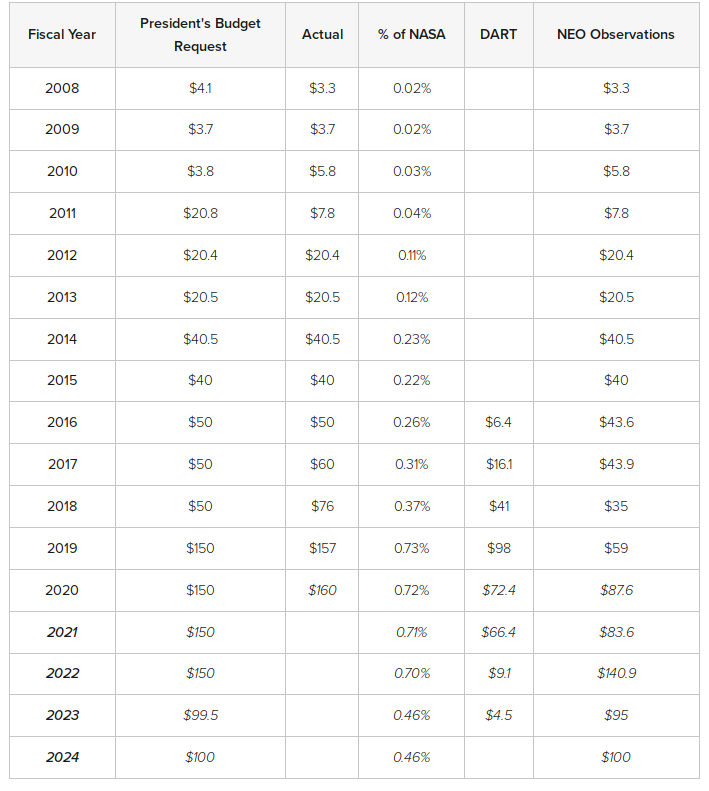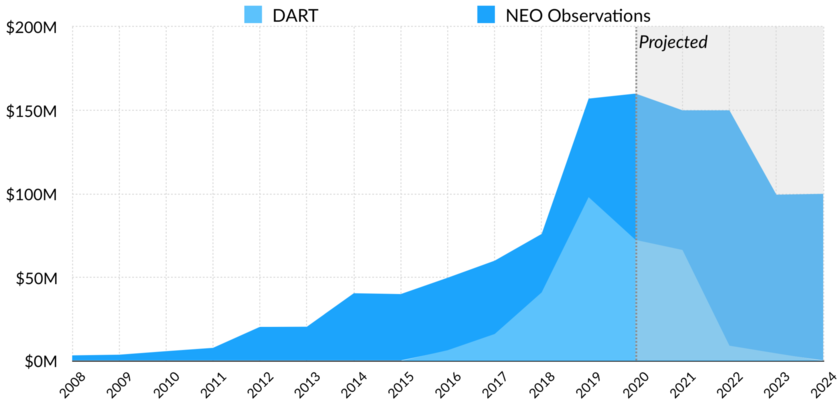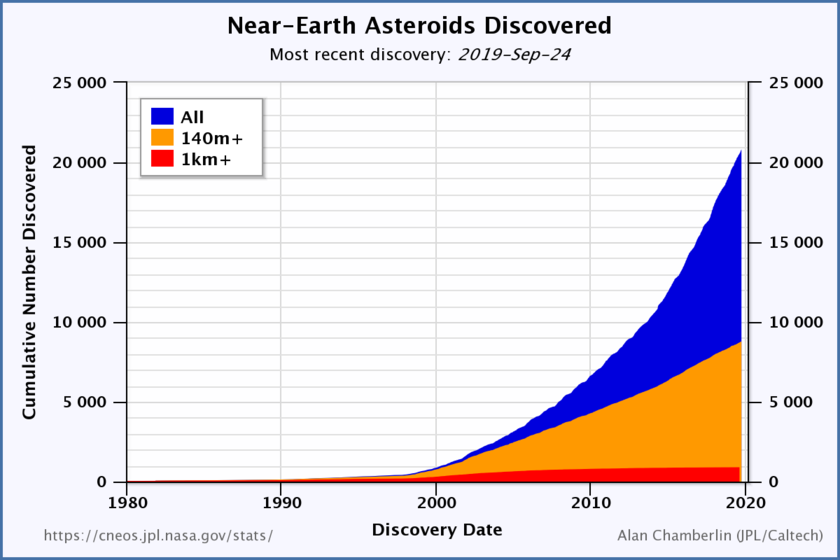
For five years after the 2005 law, NEO survey efforts at NASA limped along with an annual budget of less than $4 million per year — roughly 0.02% of the space agency's total expenditures and less than the travel budget for employees at NASA headquarters. This money supported observation time on ground-based telescopes around the world — an important but ultimately inadequate method for detecting the extremely faint signatures of near-Earth objects.
This began to change in 2010. That's when the White House, for the first time, proposed a 5-fold funding increase for NEO observations, kicking off a decade-long trend that transformed the effort from a limited, ground-based sky survey into a full-fledged planetary defense program with its own flight line for space missions. This year, NASA will spend $150 million on planetary defense, 40 times more than in 2009. This growth happened only in the past few years: in 2018 and 2019 NASA will spend as much on planetary defense as it did in the entire previous decade combined.
So what happened?
The arguments in favor of an extensive NEO survey program are not any different today than they were in 2005. Everyone knew that getting hit by a big asteroid would be bad and that we needed to search for potential threats; that's why Congress passed the law it did. In the absence of new data or external events we should look to politics: why would the NEO observations suddenly warrant increased political attention required to drive funding?
The first 2 significant jumps in funding — from $4 million to $20 million as proposed in fiscal year 2011 and from $20 million to $40 million in fiscal year 2014 — both align with proposed asteroid missions in human spaceflight. In 2010 the Obama Administration released its National Space Policy, which stated that the United States should send humans to an asteroid by 2025. In its fiscal year 2014 budget request, NASA revised this idea by proposing the Asteroid Redirect Mission, which would have robotically placed a small asteroid in lunar orbit to be explored by astronauts. Both of these human spaceflight initiatives required a specific type of asteroid in a specific type of near-Earth orbit to meet their needs. Few suitable asteroids had yet been discovered, limiting potential encounter opportunities. But scientists predicted many more were out there, awaiting discovery if they just had the resources to look. It is very likely that the needs of the much larger and politically influential human spaceflight program thus drove a 10-fold increase in funding for NEO observations.

More recently, NEO-related missions became relevant to parochial interests in Congress. The Double Asteroid Redirection Test (DART) mission concept began receiving funding via congressional appropriations in fiscal years 2017 and 2018 — before NASA formally proposed the mission in fiscal year 2019. Though DART is an important and relevant test of asteroid deflection, the sudden congressional interest likely stemmed from the fact that it is managed by the Johns Hopkins Applied Physics Laboratory (APL) in Maryland. APL was wrapping up development of the Parker Solar Probe in 2017 and had no other planetary missions in the pipeline (APL contributes to the Europa Clipper but does not manage the program). DART solved that problem.
Comment: It's not just NASA that deems there to be a very real threat from asteroid impacts: Russia's Academy of Sciences begins work on countering 'hazards' from outer space
The addition of a full-fledged flight project to an already growing NEO observations program effectively tripled the program's budget. It now can pay for more ground-based NEO surveys, support radar observations of near-Earth asteroids, and take over spacecraft operations such as NEOWISE. The rates of detection after 2010, shown below, demonstrate the benefits of this investment.
Comment: New and more profuse technology is definitely not the only reason detection rates have rocketed: Michigan Meteor Event: Fireball Numbers Increased Again in 2017
Given these growing responsibilities, NASA rechristened the NEO observations program as "Planetary Defense" in fiscal year 2018, promoting it from a subprogram within the Planetary Science Research and Analysis account to a major program line within the Planetary Science Division. It now rubs budgetary shoulders with the Mars Exploration, Discovery, and New Frontiers programs.
The yet-to-be-named telescope would launch as soon as 2024, as part of NASA's new, multi-pronged approach to planetary defense.
Another recent and significant development is the establishment of a mission flight line for Planetary Defense within NASA. This will enable an ongoing series of small-to-medium-class missions in support of detection and deflection efforts. DART is the first of this line, and NASA just announced its intent to pursue the NEO Surveillance Mission (NEOSM) as the second. NEOSM is an infrared space telescope dedicated to NEO detection and will rapidly find and characterize those 140-meter objects mandated by Congress in 2005. NASA officials predict that NEOSM will allow the space agency to meet the congressional mandate of finding 90% of those objects 15 years faster than using traditional ground-based telescopes.
After years of struggle to address critical planetary defense needs, NASA is finally prioritizing the effort and finding supporters (and funding) in Congress. However, even after 4200% growth in 10 years, NASA still spends a mere 0.7% of its budget on planetary defense. There is more room yet to grow. But if history is any guide, the long term effort to protect the Earth from dangerous asteroids will have to address more prosaic and immediate political needs along the way.
Casey Dreier Chief Advocate & Senior Space Policy Adviser for The Planetary Society





R.C.